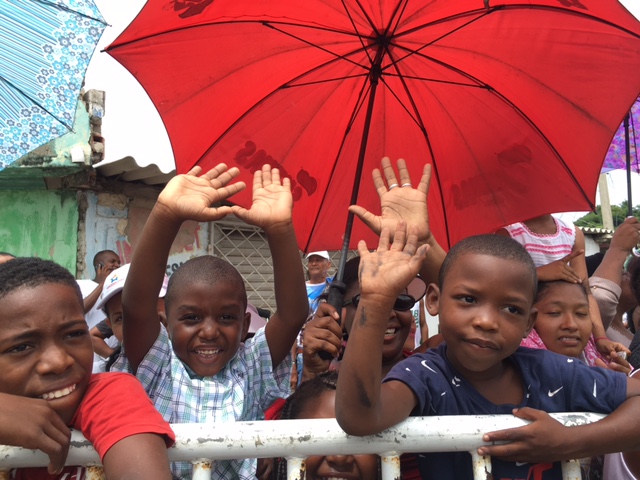
A week ago today, I found myself standing on a street corner in a Cartagena slum with a handful of photographers, camerapersons and reporters—what is known as a tight pool. As always when we cover the Pope, we were dressed in black. Sweat was soaking through our clothing and I could feel the drops running down my legs. A crowd of Afro-Colombian children cheered and reached out at us from behind metal barriers. I took their pictures and they laughed and waved. Behind them, people were in the windows and on the roofs of every shack, perched in trees, and hanging on telephone poles.
Moments later, a rumble of engines, and two lines of Colombian cops on lime green motorcycles with red, blue and yellow striped Colombian flags on their handlebars surged into view. About thirty motorcycles roared past us so fast and close, I thought they would squash my toes. We stepped back against the barriers. The crowd went wild as the Popemobile appeared in the distance. “Stay down, don’t block their view!!” Matteo Bruni, our fearless leader from the Vatican press office, ordered us. But it was too late. The Popemobile was pulling up, the crowd was reaching and waving and chanting and we were working, filming, and snapping photos.
The Pope stepped down from the Popemobile and it was mayhem. He took a few steps down a small lane and stopped to touch a baby’s head. Suddenly babies started popping up in the air. People were passing their babies hand to hand above the crowd forward towards the Pope. There was a sweet little baby all decked out in pink with a beaded headband on her little hairless head, who was hoisted forward looking perplexed. A baby boy dressed in yellow shorts, his big head flopped forward on an invisible baby neck, was lowered towards the Pope. Another baby yowled as he was passed forward, and I noticed another one who seemed to be asleep as she was sent towards the man in white. I think Pope Francis’ Chief of Security, Domenico Giani, realized this could get messy and moved the Pope forward down the lane.
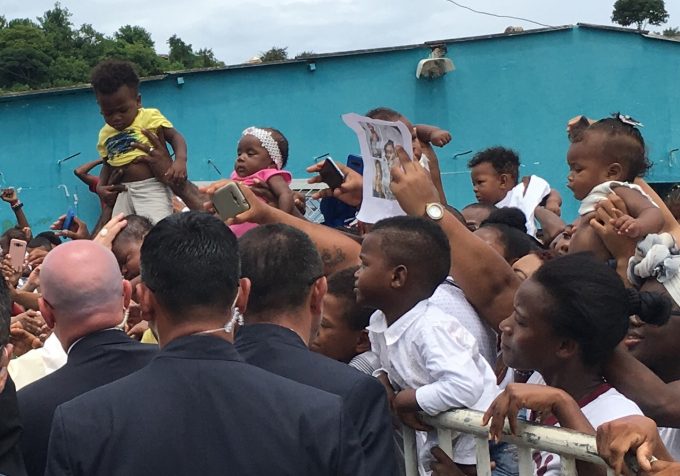
That moment seemed to sum up a lot of the Pope’s trip to Colombia for me, a chaotic, jubilant free-for-all and the Pope loving every minute of it.
When we returned to our press bus, AP Photographer Andrew Medichini said that the Pope had a cut and bruise on his face and some spots of blood on his white vestments. He showed me his close-ups taken with a powerful lense. We later learned that a few hundred meters before pulling up on the corner where we were waiting, the crowd broke through the relaxed police lines and surged around the Popemobile, causing the driver to brake, and the Pope – who was just reaching out to touch a child—slammed his face on the front glass. He spent the rest of the day minimizing the incident and told Mexican reporter Valentina Alzaraki on the flight home that his big purple bruise was just like a “plum compote” (something they eat in Argentina apparently).
Associated Press had a team of four on the papal plane flying to Colombia – Nicole Winfield, the print correspondent, Andrew Medichini, the AP photographer, Gianfranco Stara, the AP Television Cameraman, and me, the AP television producer. We also had a big AP team already on the ground in Colombia.
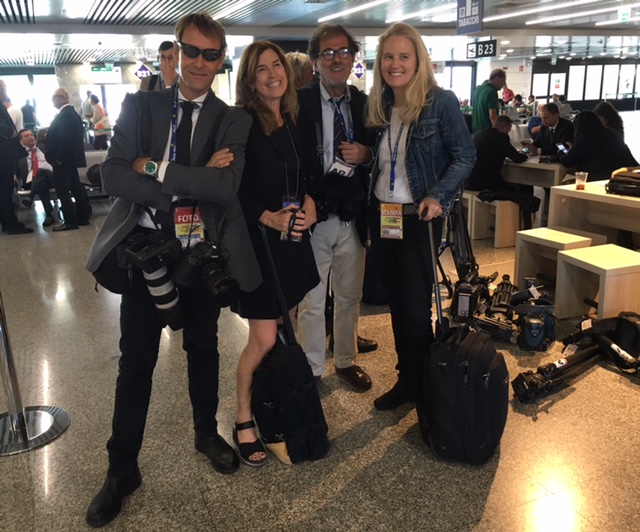
The flight from Rome to Bogota’ took 13 hours. The route was altered at the last minute so we could swing southwards and avoid hurricane Irma. The Pope came back to the rear of the plane where the 73-member press corps was seated and spoke to us briefly, talking about the importance of taking the first step towards peace in Colombia. He then went around and greeted each of us individually.
As soon as the plane landed, I was with the pool of reporters/photographers that skipped the airport welcoming ceremony and were whisked off to the Apostolic Nunciature – where the Pope stayed during his visit – to be able to film the welcome events there. The Nunciature was a beautiful old Spanish Colonial building on a small street. It was packed with a large group of teenage children. Looking at them, it appeared to me that many of them might have some slight mental disabilities.
When the Pope arrived, they burst into a series of songs and dances. I particularly liked a rapid rap number with a repeated burst of “FRAN-CIS-CO!!” as the dancers in white t-shirts, white pants and red, orange, green and blue caps jumped and dove about. Then there were more traditional dances with women in long flowing dresses men in bowler hats.
Their gaiety was so infectious that everyone, including Pope Francis, was quickly caught up in it. He urged them not to “let themselves be robbed of joy and hope.”
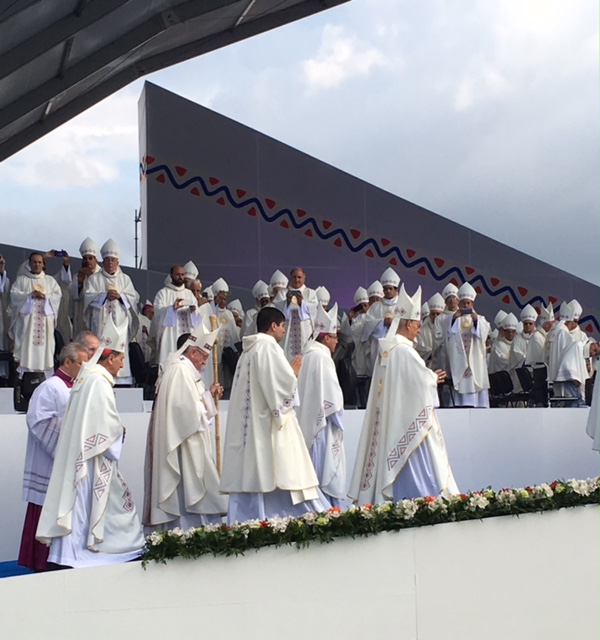
Throughout the trip, most events were dominated by a huge number of young people with lively dancing and singing to the point where the RAI correspondent commented during the Mass at the port in Cartagena “what does this music have to do with a liturgical celebration?” Clearly Colombia has a much more youthful population than aging Italy.
Along the road all through the country children of every possible race and color stood and waved eagerly at Pope Francis. They climbed up on trees and stood on roof-tops and waved and cheered for him. According to the Vatican, 93,9% of Colombia 48 million citizens are Catholic—and it shows. Many times as the press bus raced ahead of the Pope to get to events before him, crowds along the road would push in on us, nearly blocking us, waving and cheering enthusiastically.
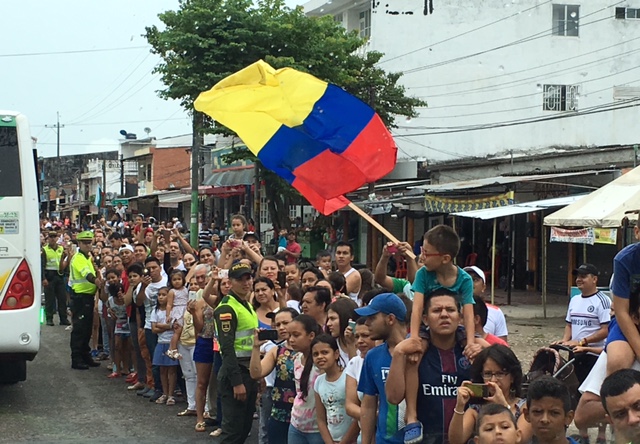
Colombia has an incredible diversity in both its land and its people. Many parts of the country we saw were deep green and luxuriant. Wherever we went we were served a fabulous variety of fruits – papaya, mango, pineapple, kiwi, watermelon, and guava.
We traveled to Villavicencio on the edge of the Amazon and to Cartagena on the Caribbean coast. They are blessed with the jungle forest and the high plains and mountains of the Andes. On one side, they have the Caribbean and on the other the Pacific Coast. The population is as diverse as the landscape with white people, black people, and everything in between plus an indigenous population.
At the Mass in Villavicencio, indigenous people waited near the bishops to greet the Pope.
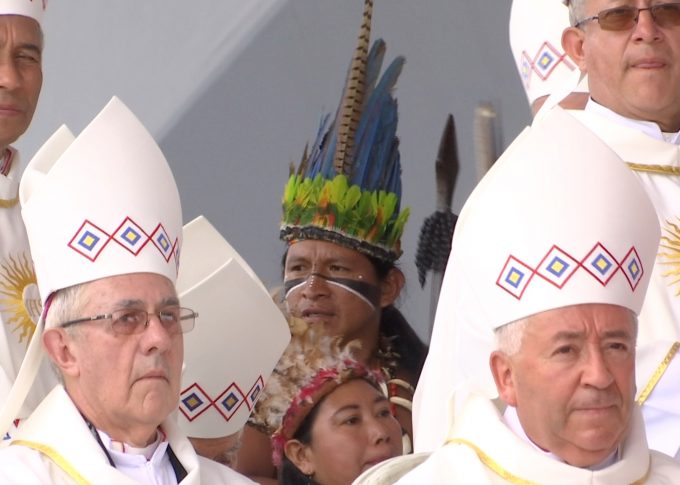
In Cartagena, the Pope visited an Afro-Colombian neighborhood where the residents are descendants of African slaves. Cartagena was the largest port for slave ships in Latin America.
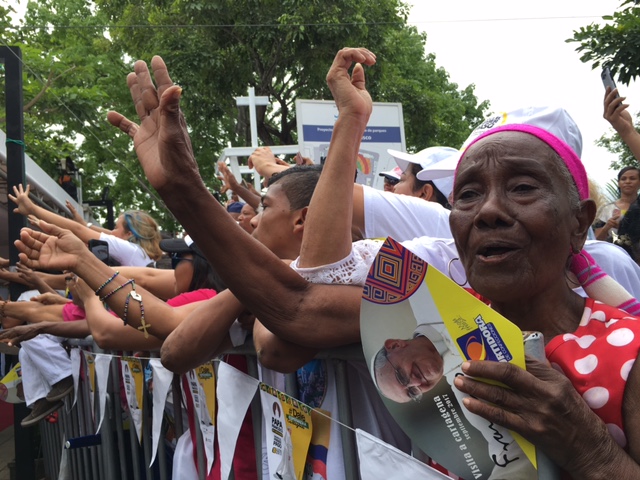
During the reconciliation ceremony in Villavicencio, Gianfranco and I spotted this Nukak Maku family, a nomadic group at risk of extinction. They live in the rainforest but have been pushed off their hunting grounds by loggers and coca growers. Over the past few decades the group has had to flee fighting between the FARC rebels, right-wing paramilitary groups and government forces.
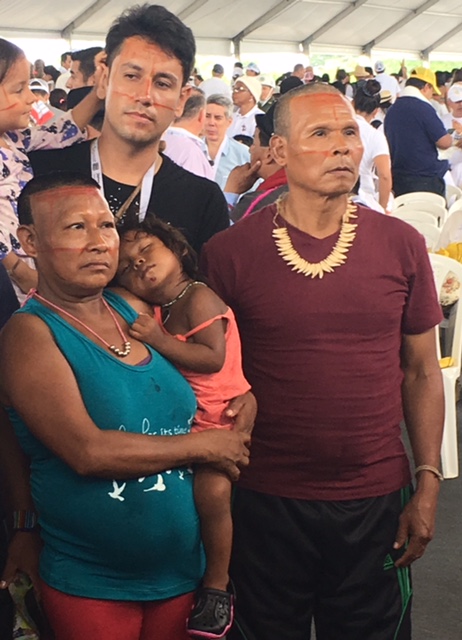
PEACE AND RECONCILIATION
The motto of the trip was “let’s take the first step” and Pope Francis spoke of peace, reconciliation and forgiveness in every speech. The idea of peace is still very fresh in Colombia. Just last year the Colombian government signed an agreement with the FARC (Revolutionary Armed Forces of Colombia) rebels bringing an end to five decades of war that have left 250,000 dead, 60,000 missing and millions displaced. The Pope wanted to do his part to support the peace efforts.
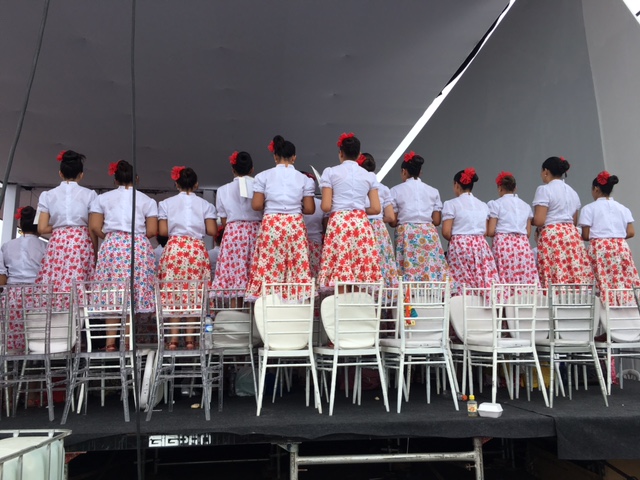
The highlight of the trip was the “Great Prayer Meeting for National Reconciliation” held under an enormous tent in Villavicencio an area once in FARC rebel territory.
Hung above the altar was the mutilated crucifix from the church in the village of Bojaya. The legs and arms of the Christ figure on the cross were blown off when a mortar shell hit the church during fighting between rebels and a paramilitary group in 2002. Residents of the town had huddled in the church for safety during the battle and at least 79 died and 100 were injured. A group of 16 survivors from Bojaya attended the event. One of them, Leyner Palacios, told my colleague that they had traveled for days using boat, plane and bus to bring the damaged Christ to the event.
The most powerful speaker at the event, who left most of us with tears in our eyes, was a wiry, grey-haired woman named Pastora Mira Garcia. She told of how, at age six, she lost her father in fighting between rebels and paramilitary forces in her village. Years later she ended up caring for his assassin when he was old and abandoned by his family. When her daughter was two months old, she lost her husband to the fighting. In 2001 paramilitary soldiers took away her daughter and her body was not found for seven years. During that time Pastora began to work with victims of the violence and their families.
In 2005 paramilitary soldiers assassinated her son. Three days after she buried her son she took into her home an injured young man. She put him in her son’s bed. Before he left her home he told her that he recognized her son in his photo and he was one of the people who had tortured and murdered him. Then Pastora Mira Garcia told the Pope, “you have to forgive the unforgivable.” I don’t think there was a dry eye left in the tent in Villavicencio at that point.
Another speaker, Juan Carlos Murcia Perdomo, described how he was recruited by the FARC rebels when he was 16-years-old. For 12 years he remained with the rebels and became a squad leader. He said he believed deeply in the “revolutionary cause.” One day while working with explosives he blew off part of his arm. Eventually he became disillusioned and left the FARC. He now works with an organization that tries to keep young people from getting recruited by drug or arms dealers. He said he tries to transmit to them a passion for truth and justice.
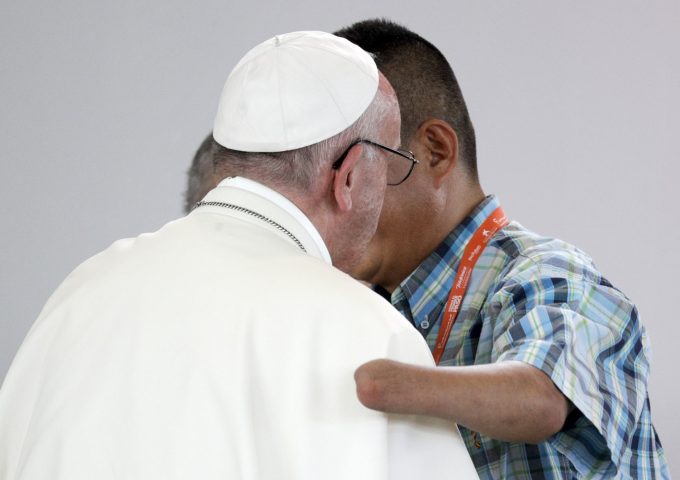
SECURITY
As I mentioned above, many of us traveling with the Pope found the security to be very lax. There were tons of soldiers and police everywhere, but they didn’t seem too intent on protecting the Pope. Perhaps it is because those of us coming from Rome are living in a major European capital where fear of random terror attacks is palpable. After attacks in Paris, Brussels, Nice, Barcelona, and London, Europeans have almost become paranoid that someone might run them down as they are walking to work or that any suitcase left alone for a moment must contain explosives.
Traveling to other countries in the world with the Pope – Turkey, Jordan, Israel, the United States and Mexico – the security has been air-tight with our equipment bags checked many times throughout the day by sniffing dogs and the crowds tightly controlled.
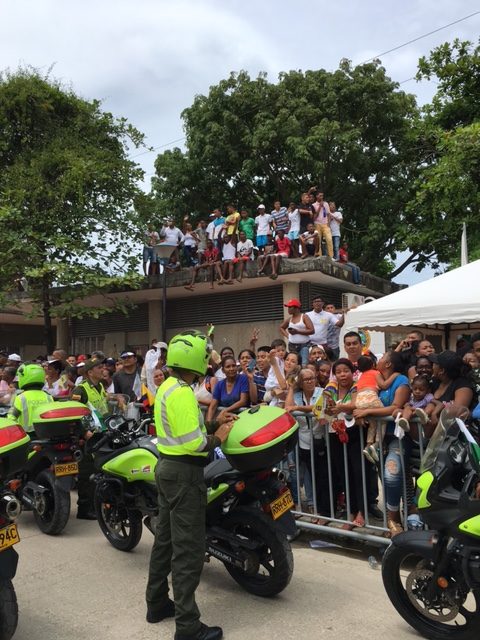
This was not the case in Colombia. From our first day there people were pushing past police lines and rushing up to the Popemobile. I was astonished to see a man burst out of the stands and throw himself on his knees in front of the Pope as he made his way down the red carpet with Colombian President Juan Manuel Santos heading for the Casa De Narino, the presidential palace. Nobody seemed to bothered about it, and once he had broken the ice, others did the same, racing right up onto the red carpet.
STICKY FINGERS
Colombia has a very young population as well as a poor one. Many people told me before and during the trip that the peace process will go nowhere if the country’s gross inequalities are not addressed. During our brief visit there, one manifestation of the poverty was the problem of sticky fingers when it came to our equipment. Before we even got to Bogota’ we heard that a TV camera belonging to a US Network had disappeared from the press room. Some power cables also disappeared during the week from the AP booth in the press center.
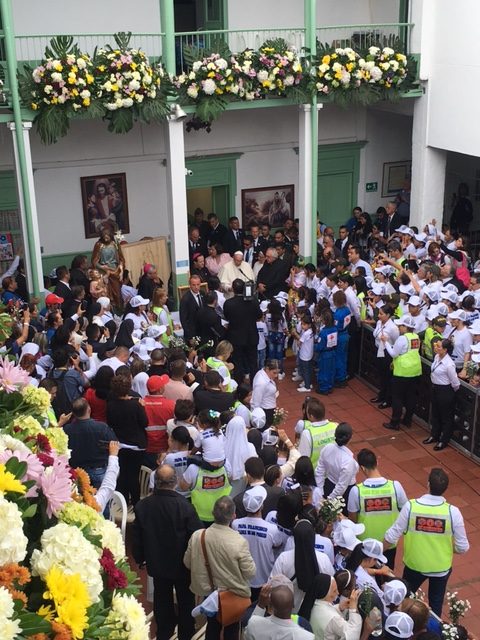
The afternoon we were in Medellin, I was in a tight pool that was taken to the San Jose Orphanage where Pope Francis was to meet 300 children. A huge crowd lined the street outside, serenading the Pope from a balcony and cheering from rooftops. We were let in through a large metal door that banged closed behind us leaving us in a beautiful old Spanish Colonial structure painted white with green balconies loaded with flowers. Hundreds of little girls gathered along an inside courtyard, all with their long hair in neat braids and with t-shirts that said “Pope Francis, Father of the Poor.”
The photographers and cameramen took up their positions along the edge of the courtyard and left their equipment on a nearby platform. I flitted about taking photos as usual as we waited for the Pope to arrive. Just before the Pope entered, the organizers allowed the girls to move into the courtyard and they rushed forward blocking our view. We adjusted positions and began to work. Then suddenly, Simone Risoluti, a photographer for the Vatican, turned around and discovered his photo bag with all his equipment, cameras, long lenses, his wallet, passport and memory cards, was gone. He began running around the orphanage checking under beds and in bathrooms, frantically looking for his bag. Then Stefano Rellandini, the Reuters photographer on the trip, turned away from the Pope to discover his 200-400mm super telephoto lens was missing (these cost around 10,000 dollars). Eventually the Colombian police were activated and, before the Pope left the orphanage, the equipment was found tossed under a bush. The person with the sticky fingers must have gotten scared.
THE QUIRKY PAPAL PRESS CORPS
On these trips, we tend to sleep about five hours a night and spend long hours together in often uncomfortable situations. We all get to know each other a little too well and know who needs a bathroom, who needs a smoke, and who needs to eat.
FOOD
Our first evening in the Hotel Tequendama in Bogota’, we noticed an unusual yellow bust of Pope Francis in the lobby bar area surrounded by desserts. The next morning I noticed that the Pope’s double chin on the bust had increased slightly over night and realized that it was made of butter. I figured that was why they were keeping the air-conditioning blasting in the hotel lobby. Bogota’ is fairly cool, so it was not necessary.
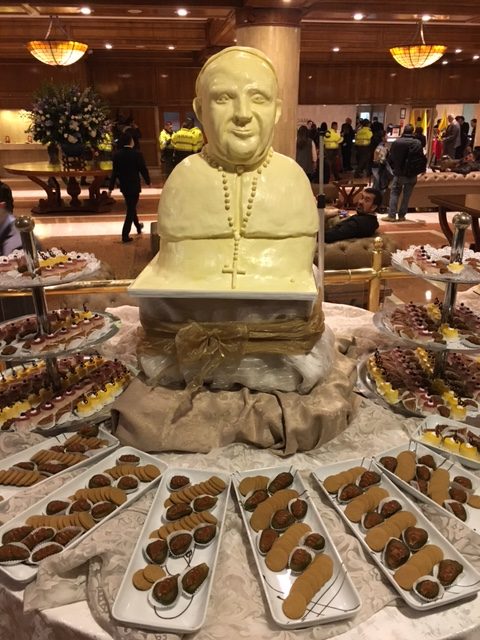
Our second evening in the hotel, the Mayor of Bogota’ held a dinner for the press corps in the hotel’s dining room. We were served the traditional Colombian Ajiaco soup made with chicken and potatoes with beans and sour cream on top. In addition, we were given a slice of avocado, a scoop of rice and a green fruity drink. The Italians were thoroughly unimpressed insisting that they needed some pasta and some meat. Four photographers ended up at a Bogota’ Mcdonalds. I liked the food but found it a little odd that all the waiters, male and female wore hair nets and many also sanitary masks over their mouths.
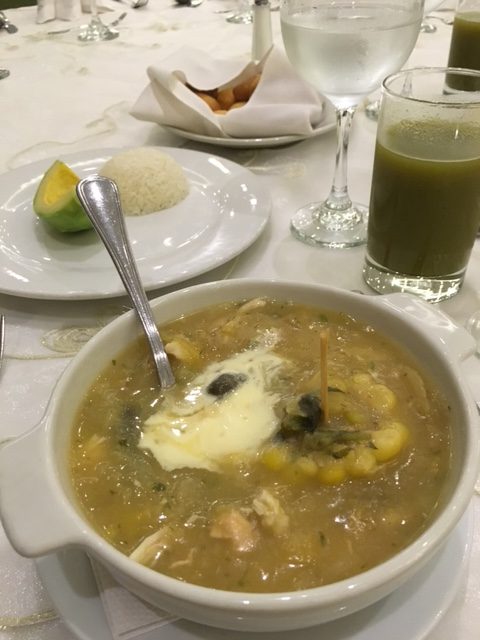
SLEEP
Sleep, or lack of it, tends to become an obsession on these trips and many of us couldn’t adjust to the time change so had trouble making use of the 5-6 hours we were allowed. There is nothing worse than being absolutely wide awake when you know you have to get up in 4 hours. After two days of that, my colleague, Nicole Winfield slid me two blue gel pills – that she claims you can buy over the counter in the US– that did the trick so well that the next morning I did not wake up. Nicole called me from the breakfast room at 4am asking “Are you awake?” “Barely” was the correct answer, but the shock of oversleeping gave me such an adrenalin kick that I was dressed in five minutes and running down the corridors of the Tequendama.
BATHROOM
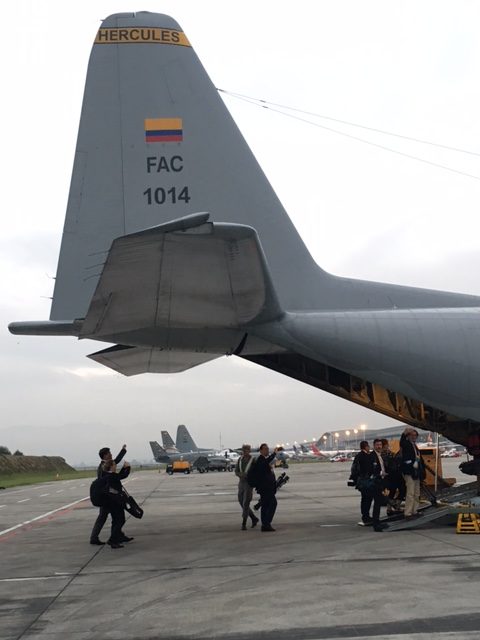
Of course, when you have hardly any sleep and you have to concentrate to work, one tends to drink a lot of coffee. The problem is if you are then popped on a bus and taken to a three-hour Mass, you can become desperate for a bathroom. My female colleagues and I make a point on these trips of scoping out available bathrooms to solve this problem. On the morning we flew to Medellin, we all assumed that we could use the toilet on the plane from Bogota’ to Medellin. But the plane was a Colombian Air Force C-130 Hercules with no bathroom. When we got off the plane at a military base, Colombian officers were rushing us off to buses for the trip to the Mass. I decided to take the initiative and approached Salvatore Scolozzi from the Vatican Press office pleading with him on behalf of the Vatican Female Press Corps Pee Lobby to see if there was a toilet on the base. Fortunately, our request was granted and there was a long line of us marching off to the facilities (not just women either).
ACHES AND PAINS
On these trips we carry a ton of equipment. Gianfranco has his camera, tripod and a belt bag filled with batteries and cables. I have my computer bag filled with various mi-fis and cables. Some days I really feel like little Miss Mi-Fi. To make sure we had all available transmitting options, I had an Italian Vodafone Mi-fi (didn’t work), my own cell phone which was roaming on the Colombian Claro system, a TIM Mi-fi with a local Claro sim card in it, and an extra Iphone with a local Claro sim card. I was constantly fiddling around with cables and chargers and external batteries. With all this stuff in it, my computer bag/trolley was very heavy. We often have to scurry on and off buses, and planes, in an out of events, on and off altars and press platforms, lugging our material, and bumping and banging ourselves. On the second day as I was about to get in the shower I noticed a huge bruise on my rear end. Not sure how that happened, but I am pretty sure it was getting on or off the bus the first day with all my equipment. On the second day a bruise popped up on my arm. I mentioned all this to my AP photographer friend Alessandra Tarantino when I got back. She and I did the Cuba/USA trip together (see blog posts “Hope, Dreams and Humidity with Pope Francis in Cuba” and “Hacks in Black: On the Papal Plane with Pope Francis.”) Alessandra said, “Are you kidding? Going on a Papal trip is like covering a war zone! I come back with bumps and bruises everywhere!”
EMERALDS
Before I left I bought a guide book to Colombia and began reading up on the country. I discovered that Colombia is the country with the most emerald mines in the world and I decided if I had a free moment I must go see the open-air emerald market in Bogota’. But I spent the whole time running from one event to the other. However, my friends from the US Networks had a little more time than I did. Hurricane Irma pushed the Papal trip out of the headlines and there was not so much interest in the trip. On the flight back, I leaned over the seat in front of the CBS producer as she was busily translating the Pope’s press conference. She had a big emerald ring on her finger! I asked her how much she paid and she said “two.” “Two hundred?” I asked. “Add a zero,” she responded. Across the aisle the CNN correspondent was also wearing a new emerald ring with a row of small emeralds on it. I was green with envy. AP definitely does not pay me a big enough salary for emerald shopping!
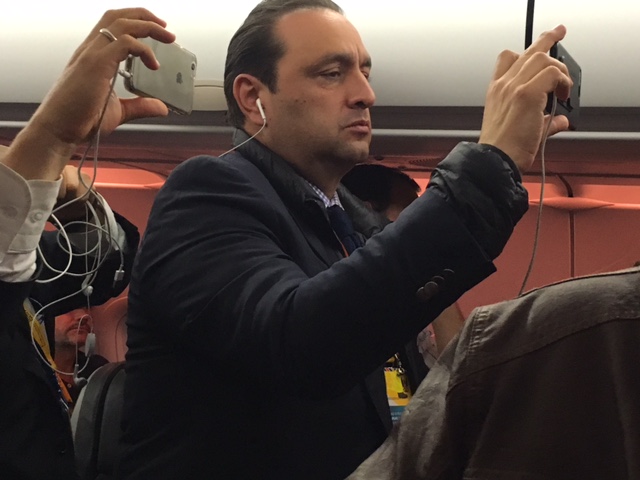
Often on Papal trips, correspondents will come from the country the Pope is headed to and join the press corps on the Papal plane. This way those correspondents will have access to all the pools, the speeches and the Pope’s press conference on the way home. This trip was no exception, there were several correspondents from Colombia, but one – who we nicknamed MR 13-HOUR LIVE – drove us insane. It started as soon as we boarded in Rome and he began doing live stand-ups in the aisle of the Papal plane. That is relatively common, many correspondents do that. But then we took off and unfortunately the plane had both Wi-Fi and telephone service. He started in doing live reports using two cell phones. 13 hours straight of this guy saying basically “I am back here with the ‘periodistas’ and Pope Francis is up there….” It was crazy. But then he continued throughout the trip, every bus ride, every event, it was one long constant live shot. The only times he seemed to stop his live reporting was when we were at events and his many fans came up and asked for photo with them. He would inevitably poise pointing a finger at them. Eventually his incessant lives prompted a member of the Vatican press corps to make an official request that the wifi and the phone lines be blocked on the flight home.
CONCLUSION
I was so struck by all the beautiful, positive children and young people I met in Colombia that I want to end my post with a few photos of them.
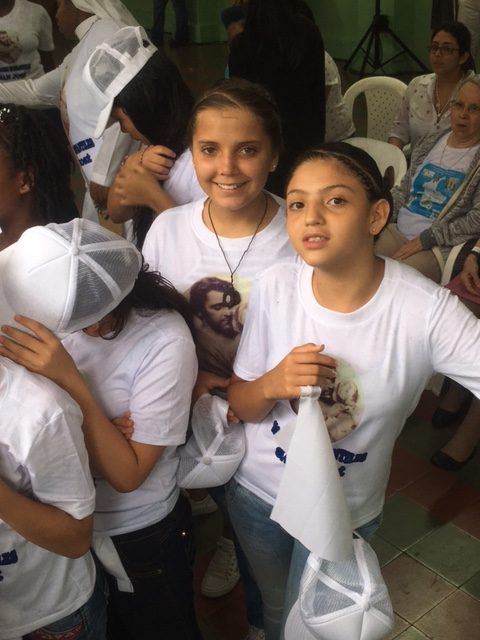
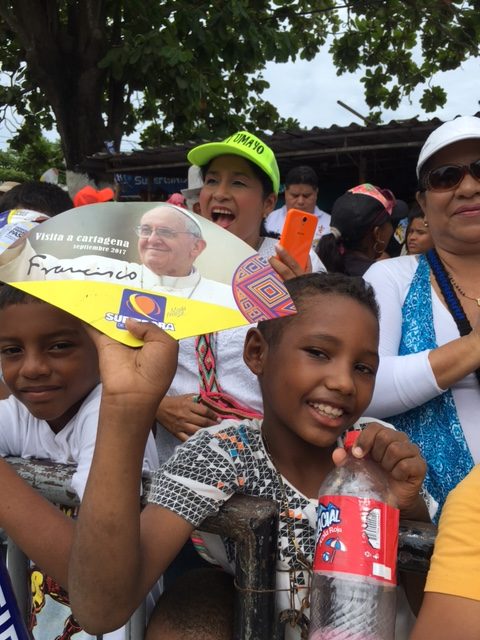
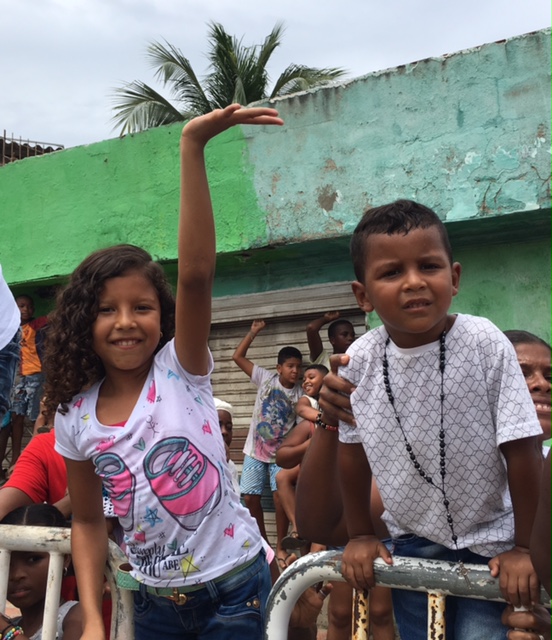
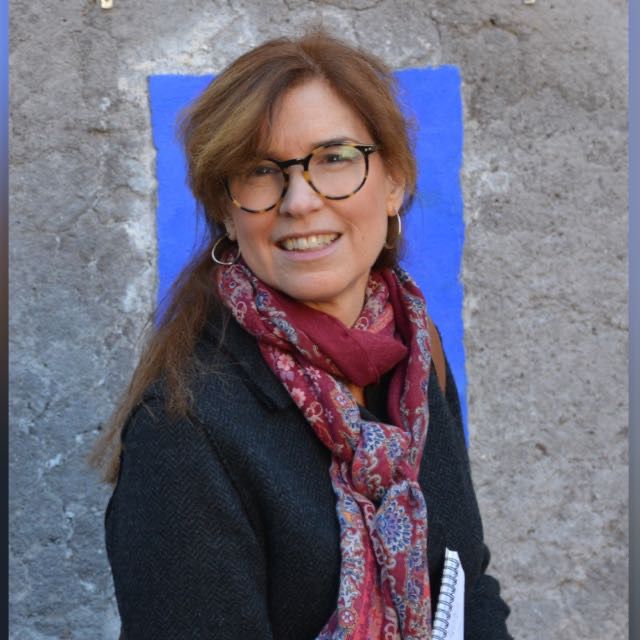
Fascinating trip. I would love to learn more about where the politics stand. Will you be writing more about that?
Thank you! I could write much more about the trip, but I don’t think I can do anything worth reading on the politics. It is all so complicated and having spent only five days there, stuck in my Papal entourage bubble, I am definitely not qualified to report on it. I would love to go back and learn more though.
Great read, Trisha! Both funny and sad and also informative. I don’t think that combination can be topped very often. Thank you so much for sharing your adventures and your thoughts. I always look forward to them.
I thought I had commented yesterday, but since it didn’t show up, I will blame my tablet which is getting old and battery was running low. So who knows?!
A presto,
Joan
Thank you Joan!! No, your comment did not show up yesterday, but it is here now and I appreciate it very much. Was a bit of a long post. So much to say about the trip and I barely touched the surface. Grazie mille for even reading my super-long posts!
Terrific photos Trisha and a great commentary but I cannot/will not get my head around this ‘organised religion’ nonsense. As long as this sort of stuff continues there is no hope for the human race.
Thank you Alan. I appreciate your making the effort to look at/read and comment on my blog even if organized religion is not your cup of tea. I have been really slacking off and having trouble keeping up with blogging and commenting on others. Will zip over to your blog now and see what adventures have been keeping you busy.